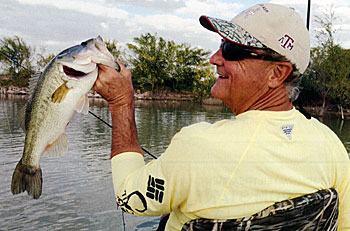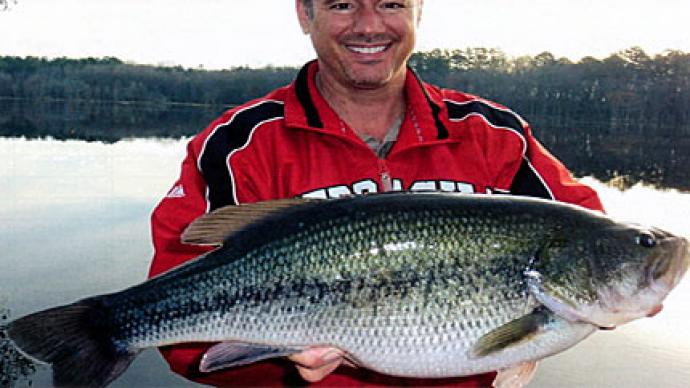
Managing your fishery means knowing how and when to make the best decisions. For years, we've spread the gospel about clean healthy water and preached the four primary principles to help create and manage the best fishery: great habitat, super food chain, the best genetics and harvest.
In our last article, we zeroed in on another important tool for you to use to make the best choices: relative weight. Relative weights of your fish give you information to make good choices about how to manage your food chain, whether you should improve habitat, change genetics or harvest fish. Weighing and measuring your fish and having something to compare gives you contrast to see when it's time to alter your management strategy.
Here's what I mean.
Say you've just taken on the task of managing a nice-sized pond on your new country place. Start by catching some fish and looking at their body condition. Keep records—I know we sound like a broken record on this topic—but keep records. Weigh and measure and compare. Over a few short months, you'll see some trends. Your fish will show signs of growth, or they'll show signs of weight loss, or they'll stay proportionately the same. Of those three, which are acceptable to you to meet your goals?
If you're like most people I meet, only one of those is acceptable—you want your fish to grow.
I'll always remember a phone call from decades ago. This excited gentleman called, wanting to order some Florida bass fingerlings to put into his newly acquired six-acre lake. That lake was legendary in local lore. It was seemingly abandoned by the former owner and the locals fished it like it was a public lake...for a while, and then it became so overharvested that the population of bass declined in size and age no one cared to fish it anymore. The new owner posted "No Fishing" signs along the shore and "No Trespassing" signs along his newly renovated fence. Little did he know the locals had given up on this lake quite some time before, simply because all they caught were small fish. As we talked on the phone, I asked him why he wanted to buy some Florida bass fingerlings. (In my mind, he was about to buy an oxygenated bag of tiny little fish, maybe two inches long.) His response was classic, "The fish in my lake aren't any good, so I want to replace them with better fish." He explained that all he and his son were catching were little, stringy looking bass, from 7-10" long. Nothing larger than that, and based on neighbor testimony, that's the way this lake had been for years. I tried to empathize with him.. .maybe those fish were so inbred and overcrowded that they WERE bad fish. But, my experience and training took hold of my judgement and my tongue. "I don't think you need to buy any bass right now." That statement was met with dead silence. I'd just lost a sale, but made a customer.
A few weeks later an electrofishing assessment told the true story of this fishery. There was very little habitat. No vegetation, no stick-ups, laydowns, rock piles, stumps...nothing. Some willow trees had sloughed off across the lake along the shore, but that was about it. The fishery? Nothing but small bass, and hundreds.. .no thousands, of them. No forage fish, no bluegills, nothing, nada. All they had to eat was each other and seasonal dragonflies.

Guess what would have happened had we stocked those tiny little Florida bass? Snack time—zero survival. On site, we started removing small bass with the electrofishing boat. Every single one we captured came out of the lake. The strategy for this lake was to remove as many bass as possible and to stock adult bluegills so we could approach some sort of balance so the bass could begin to grow.
He started feeding the bluegills as he removed more and more bass. Within the first six months, he and his son had removed more than 400 bass. Along with the 250ish we took out with the electrofishing boat, he had brought his fish population into better balance, and that would allow his bass to begin to grow again. The lake was fertilized, the feeding program was consistent and with harvesting bass, by the next spring they were beginning to catch a few larger bass, pushing close to a pound each. They kept harvesting bass.
When they started this program, relative weights for those skinny little bass were less than 80. That means they weighed less than 80% of what they should have. Some were as low as 65. Fish so thin cannot recover.
How did they know how many bass to harvest?
They watched the relative weights of bass and kept great records. One puzzling thing to them was the fact that one year later they were catching some fish which were now 95-100 and growing upwards of a pound to a pound and a quarter. But, a significant portion of fish they were catching were still around 80. That was a sign to keep harvesting fish. Some of those severely underweight fish just weren't going to respond. His question to me, "When do we stop harvesting bass?"
My answer, "When you get to the point you have enough large bass to harvest the smaller ones for you."
What I meant by that was he should expect the lake to continue producing small bass, except now they'll be young fish. Until more of his bass grew well beyond two pounds, he's going to be harvesting fish.
Part of the fun for this father-son team was adding brush piles and cinder blocks for added habitat for small fish to attract more bass.
By the end of the second year, their management strategy was showing results. They had a blossoming size range of bass. The larger fish were gaining nicely and relative weights were up, as they hoped. But, it took lots of hard work, adding habitat, catching so many small fish, filling the feeders and maintaining a good plankton bloom for the entire season. The follow up question was, "Can we stock Florida bass now?"
We did. We stocked small fingerlings at the beginning of the third year. Logically, the question was this, "Won't small fish be eaten?" They answer is, "Yes, they will." But, let's say we stock 1,000 fish and 95% are eaten. That means 50 survive to adulthood. In this lake, that's enough to integrate the Florida gene into the population. They had a good plan and monitoring relative weights have played a significant role in their management strategy.
I lost track of this duo for quite a few years.
About 20 years after this encounter, there I was giving a pond management seminar in their small Arkansas town. A man in his early 30's approached me after the meeting and said, "I know you don't remember me, but you helped my dad with a lake when I was a boy. I was about twelve at the time and man, what we learned with that lake is still with me today."
We had a nice, long conversation. The family enjoyed that lake for ten-twelve years and over that time grew some fantastic bass. He told stories of their first double-digit bass and the numbers of four to six pound bass. He spoke fondly of that piece of water and lessons learned.
I asked him how it was today.
He said, "I don't know.. .we sold it about ten years ago."
The question begged, "Why did you sell it?"
"Well," he said, "When neighbors got wind we were catching big bass like that, they started sneaking in and catching our fish. We couldn't keep them out, so Dad sold the place and we bought another one with a much better lake." While using relative weights to adjust their management strategy, those signs at the lake and on the fence just didn't make muster. The fisheries strategy worked, but the people management strategy failed.
Reprinted with permission from Pond Boss Magazine



